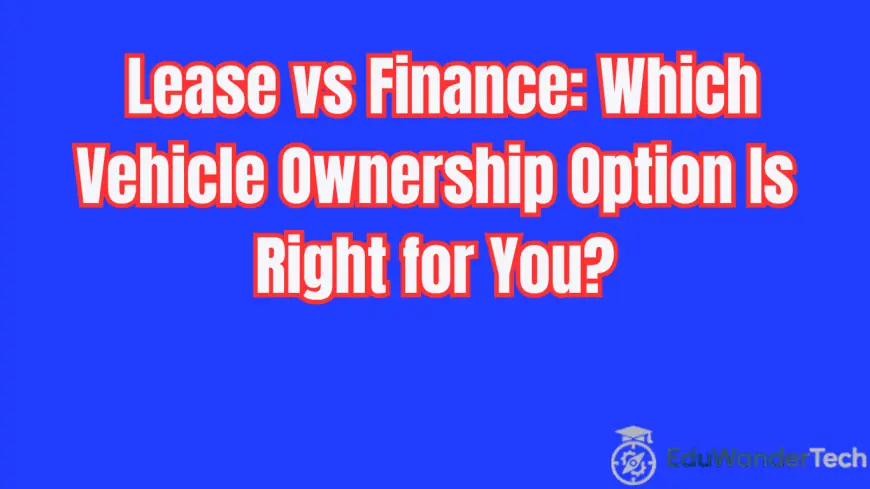Lease vs Finance: Which Vehicle Ownership Option Is Right for You?
Confused between leasing or financing a car? Learn the key differences between lease and finance options to choose the right fit for your budget, lifestyle, and long-term goals.

When it comes to acquiring a new vehicle, one of the most important decisions you'll face is how to pay for it. The two most common methods are leasing and financing. While both options offer pathways to driving away in your dream car, they differ significantly in terms of structure, benefits, and long-term implications. Understanding the difference between lease and finance can save you time, money, and stress—especially when aligning the choice with your lifestyle and financial goals.
This comprehensive guide will walk you through everything you need to know. Let’s explore the pros, cons, and key differences between leasing and financing a vehicle.
Section 1: What Does It Mean to Lease a Car?
Leasing Explained—Drive Without Owning
Leasing a car is essentially a long-term rental agreement. You pay to use the car for a predetermined period, usually 2 to 4 years, and then return it to the dealership at the end of the term. In most leases, you are only paying for the vehicle’s depreciation during the lease term, not its full value.
Key Features of Leasing:
-
Lower Monthly Payments: Since you're not paying for the entire value of the car, lease payments are typically lower than loan payments.
-
Mileage Limits: Most leases come with an annual mileage cap, usually between 10,000 and 15,000 miles. Exceeding this limit incurs additional fees.
-
End-of-Term Options: When the lease ends, you can either return the car, purchase it for a pre-agreed price, or lease a new one.
-
Limited Customization: Leased vehicles must be returned in good condition, so major modifications are discouraged.
Leasing can be an excellent option for those who want to drive a new car every few years and enjoy lower upfront costs. However, the lack of ownership and mileage restrictions can be a drawback for some drivers.
Section 2: What Does It Mean to Finance a Car?
Financing a Vehicle—Your Path to Ownership
Financing a car means taking out a loan to purchase the vehicle. You borrow money from a lender—usually a bank, credit union, or the dealership—and agree to pay it back in monthly installments over a set term, typically 3 to 7 years.
Key Features of Financing:
-
Ownership at the End: Once you’ve paid off the loan, the car is yours.
-
No Mileage Restrictions: Unlike a lease, there are no limitations on how far you can drive.
-
Customization Freedom: As the owner, you’re free to modify the vehicle however you wish.
-
Higher Monthly Payments: Because you’re paying off the full value of the vehicle (plus interest), financing generally results in higher monthly payments compared to leasing.
Financing is ideal for those who plan to keep their vehicle for many years and drive extensively. It also offers the advantage of building equity in the car, which can be a valuable asset down the line.
Section 3: Comparing the Costs: Lease vs Finance
Understanding the Financial Trade-offs
The difference between lease and finance becomes especially clear when you break down the costs. Here’s how the two options typically compare:
| Cost Component | Lease | Finance |
|---|---|---|
| Down Payment | Lower or sometimes waived | Typically higher |
| Monthly Payments | Lower | Higher |
| Maintenance Costs | Often covered by warranty | Increases as vehicle ages |
| Insurance Requirements | May be higher | Can vary |
| Long-term Cost | More expensive if repeatedly leasing | More cost-effective over time |
Over the short term, leasing may seem more affordable due to the lower monthly payments. However, financing becomes more economical in the long run, especially if you keep the vehicle after the loan is paid off.
Section 4: Who Should Lease and Who Should Finance?
Tailoring the Right Option to Your Lifestyle
Not everyone drives the same way or has the same financial priorities. Therefore, choosing between leasing and financing should depend on your unique needs.
Leasing Might Be Right If You:
-
Like driving a new car every few years
-
Prefer lower monthly payments
-
Don’t drive more than 12,000–15,000 miles per year
-
Want to avoid maintenance costs in later years
-
Don’t plan on customizing your car
Financing Might Be Right If You:
-
Plan to keep the vehicle long-term
-
Drive a lot and want no mileage limits
-
Want to build equity in the car
-
Prefer to own an asset at the end of your payments
-
Like to modify your car to your liking
In essence, leasing suits those who value flexibility and newness, while financing appeals to those seeking long-term value and ownership.
Section 5: Pros and Cons Breakdown
A Quick Snapshot to Make Your Decision Easier
To further highlight the difference between lease and finance, let’s look at a simple pros and cons table:
Leasing
Pros:
-
Lower upfront and monthly costs
-
Always under warranty
-
Easy vehicle turnover
-
No resale hassle
Cons:
-
No ownership or equity
-
Mileage and wear restrictions
-
Higher insurance premiums
-
Penalties for early termination
Financing
Pros:
-
Full ownership after payments
-
No mileage limits
-
Can resell anytime
-
Customization allowed
Cons:
-
Higher monthly payments
-
Vehicle depreciates in value
-
Out-of-warranty repair costs
-
Need to handle resale or trade-in
This clear overview helps emphasize that each option has its advantages and trade-offs. The best choice depends on your long-term plans and financial flexibility.
Section 6: Making the Final Decision: What to Ask Yourself
Choosing the Best Option with Confidence
Before you walk into a dealership or apply for a car loan, ask yourself the following questions:
-
How long do I plan to keep the car?
If the answer is “just a few years,” leasing might be ideal. -
How much do I drive annually?
If it’s more than 15,000 miles, financing will likely save you money. -
Do I want to own the car eventually?
Financing is the only route to full ownership. -
How much can I afford monthly?
Leasing usually offers a lower financial burden each month. -
Do I like to customize my vehicle?
Financing gives you the freedom to personalize your ride.
By answering these questions honestly, you’ll be much better positioned to choose the right path—whether that’s leasing a brand-new model or financing a car that will serve you for years to come.
Conclusion: Lease or Finance—It’s All About Your Goals
Understanding the difference between lease and finance is more than just comparing numbers. It's about aligning your choice with your lifestyle, driving habits, and financial goals. Leasing offers flexibility and lower upfront costs, while financing delivers long-term value and ownership benefits.
Take the time to assess your personal needs before committing to either option. Whether you choose to lease or finance, making an informed decision ensures that your new car won’t just be a smart purchase—it will also be a strategic one.
What's Your Reaction?
 Like
0
Like
0
 Dislike
0
Dislike
0
 Love
0
Love
0
 Funny
0
Funny
0
 Angry
0
Angry
0
 Sad
0
Sad
0
 Wow
0
Wow
0



















































